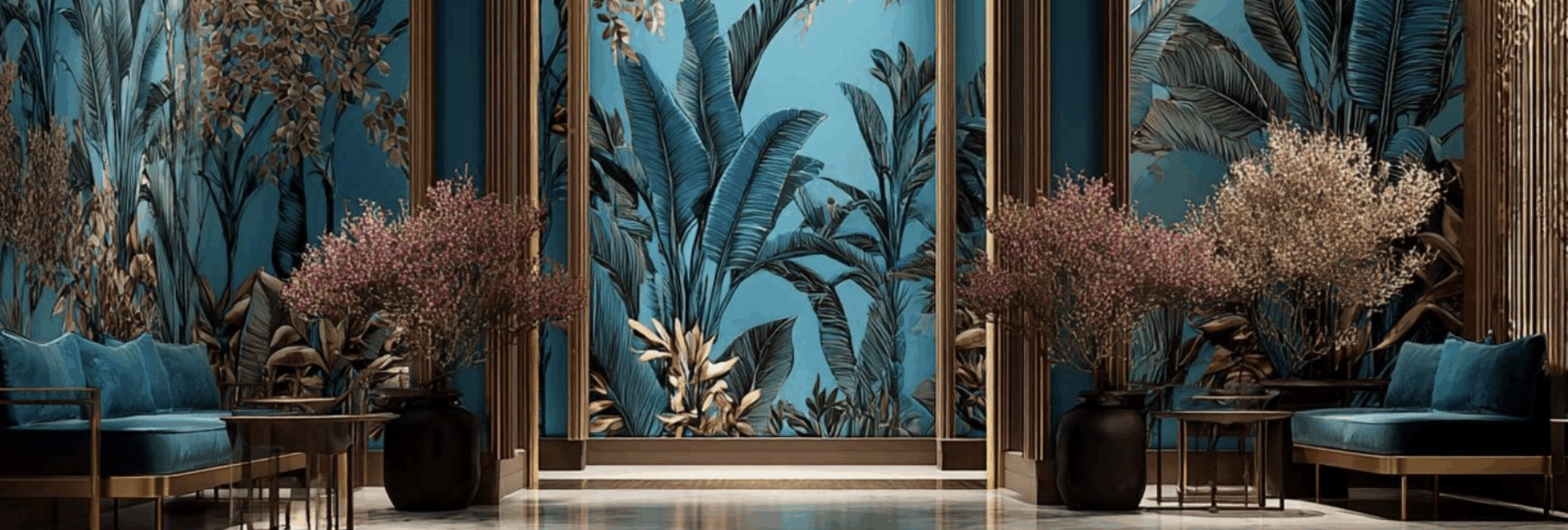Digital printing and AI are revolutionising interior design by enabling on-demand mass customisation. This shift is driven by consumer demand for personalised, rapidly delivered, and sustainable products. Businesses like Caro Group are investing in automated workflows using technologies like Canon’s UVgel to create unique, high-quality wall coverings, with AI tools expanding creative possibilities.
Digital printing has for some time been quietly disrupting interior design by overcoming the limitations of analogue methods. It enables custom designs, flexible scales, a variety of materials, and rapid delivery—all tailored to individual needs. The era of one-size-fits-all is now rapidly being replaced by personalised solutions, driven by cutting-edge technology and AI creativity.
Customer expectations for personalisation, speed, and sustainability are soaring. Generic, mass-produced products no longer satisfy the modern consumer’s desire for unique self-expression. Businesses still clinging to outdated, inefficient manufacturing models are finding themselves unable to compete. The challenge is clear: adapt or be left behind.
The solution lies in a radical rethinking of the production process, embracing on-demand manufacturing powered by digital innovation. By integrating technologies like Canon’s UVgel and AI-driven design tools, we can unlock unprecedented creative and commercial freedom, transforming not just what we print, but how we do business.
A Perfect Storm: Meeting the Demands of the Modern Consumer
The pressure on manufacturers has never been greater. Today’s consumers are not just buyers; they are creators who expect products to reflect their personal identity. This shift has created a perfect storm of industry challenges that traditional methods cannot weather:
- The Demand for Personalisation: Customers want unique, customised products. They don’t want the same wallpaper as their neighbour; they want a design that tells their story, whether it’s a family photo, an abstract piece of art, or a bespoke pattern that matches their aesthetic.
- Rising Service Expectations: The “Amazon effect” has reset expectations for delivery speed. Waiting weeks for an order is no longer acceptable. Businesses are now expected to deliver high-quality, customised products within days, not weeks.
- A Sustainable Choice: Consumers are increasingly conscious of their environmental impact. They demand products made with eco-friendly materials and sustainable processes, moving away from wasteful, stock-based models.
Meeting these demands requires a paradigm shift from mass production to mass customisation. It requires a workflow that is agile, automated, and customer-centric.
Case Study: Caro Group’s Digital Investment
To understand the power of this new model, we spoke to the Caro Group in Poland. Under the creative direction of Marta Naranowicz, the company has transformed its operations by investing in a fully automated, digital wallpaper factory. This bold move, made during the uncertainty of the COVID-19 pandemic, was a direct response to a 30% surge in sales and the growing need for a more sustainable, on-demand production model.
“My passion for print exploded with the installation of our wallpaper factory. We saw the future was in digital, sustainable, and automated production.” Marta explained.
Caro Group’s factory is a masterclass in modern manufacturing. It combines Canon’s UVgel printing technology with Fotoba’s automated cutting machinery, creating a seamless workflow that can process 200-300 unique orders daily with minimal staff. Listen to the podcast here.
This level of automation delivers enormous benefits:
- Speed and Efficiency: Orders can be produced and dispatched in as little as 48 hours.
- High Quality: UVgel technology produces prints that are not only vibrant and detailed but also scratch and abrasion resistant. Environmental efficiency is paramount – As the Feeby brand (Caro’s direct to consumer) website states, the inks are GreenGuard certified, odourless, and 100% safe for use in schools and medical facilities.
- Consistent Colour Match: Replicating previous print orders is a breeze. If a single panel of wallpaper is damaged during installation, a precisely matched replacement can be printed and sent immediately, eliminating the waste and cost of replacing an entire wall.
AI: The New Muse for Wallcovering Design
Technology isn’t just optimising the production line; it’s rewiring the creative process itself. Marta Naranowicz and her team at Caro are leveraging AI tools like Midjourney and DALL-E to push the boundaries of design.
“AI technology has expanded our team’s creativity” Marta explains. By using carefully crafted prompts, her designers can generate vast archives of unique patterns, textures, and images almost instantly. This allows them to stay ahead of trends and create entirely new collections at a speed unimaginable just a few years ago.
One of Marta’s favourite projects is an abstract, non-graphic wallpaper created with AI. It’s a design that feels organic and textured, a world away from traditional repeating patterns. This innovation is only possible because of the synergy between AI-driven design and the precision of digital printing. Canon’s UVgel technology, with its FLXfinish+ feature, can reproduce these complex designs with stunning clarity and even create tactile surface effects, realistically mimicking expensive materials like wood panels or raw silk.
A Creative and Commercial Awakening
The path forward is clear, yet many in the industry hesitate, tied to the perceived safety of traditional methods. “They see the investment in new technology as a risk rather than what it truly is: the essential cost of doing business in the 21st century. Copying competitors is a race to the bottom. True leadership comes from innovation.” Marta Naranowicz.
As Marta Naranowicz puts it, “the new digital factory is like a “Lamborghini”—it requires skill and dedication to master, but its performance is unmatched. The time has come for the wallcovering industry to get behind the wheel”.
“We must embrace the creative and commercial freedom that digital technologies deliver. For print service providers, this means investing in automated, on-demand workflows. For designers, it means exploring the limitless potential of AI tools. For brands, it means offering customers the personalised, sustainable, and rapidly delivered products they demand”.
The future of wallcoverings is already here. It’s digital, it’s automated, and it’s driven by a fusion of human creativity and artificial intelligence.
